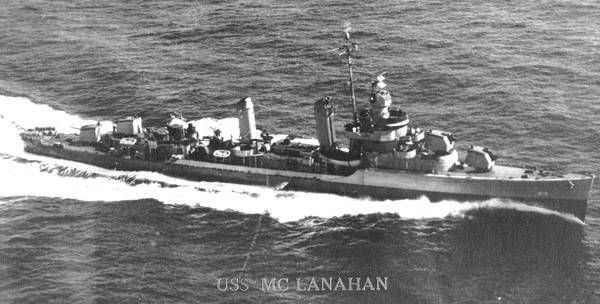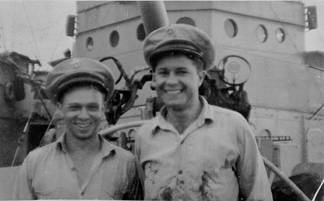
DD615-sent in by George Smith WTC.
Reflections of the USS McLanahan DD615

DD615-sent in by George Smith WTC.
I put her in commission on December 19, l942, after serving as part of her pre-commissioning crew. The Capt. was Lt. Comdr. H.R.Hummer, USN. I was the Watertender First Class in the foreward fireroom. After shakedown in San Diego was completed we headed for the canal and the east coast. As I recall we had one contact with a sub going through the windward straights dropping some depth charges. If we were effective is a question mark. On the east coast we were assigned to Destroyer Squadron 16 and commenced our assignment as escort for fast convoys. I recall making trips to Swansea, South Wales, Greenock Scotland and Northern Ireland. The people were very receptive and made some good liberties. In June l943 we were ordered to Algiers, North Africa and in the following month we assumed various duties as anti-submarine screen for the landing forces off the coast of Gela, Sicily. And in addition we were the relief flag ship for Admiral Hewitt. The first assault waves landed on the Gela beaches at approximately 0245 in the glare of search lights which we soon knocked out by destroyer gunfire. Prior to day light unseen planes proceeded to bomb at will and one unseen German plane dropped a near miss on the Maddox and two hits on the fantail and the stern was blown wide open. In two minutes she had sunk. Nine officers and sixty five men were saved out of a total of 284 on board. The exchange of bombs and anti-aircraft continued for the next two days. German aircraft continued to hassle us and we in turn continued to fight back. During the night they would drop magnesium flares to light the targets and bombs fell in clumps, cascades and clusters. Every ship in the area was shaken by close straddles and we were shaved by a close one which bounced our stern out of the water.  The Liberty Ship Robert Rowan (pictured above), which was carrying ammunition, took a bomb down their forward hold in front of the bridge and it started a fire . The crew evacuated the ship and our skipper decided to take them aboard. I remember looking out the fireroom hatch and could see the smoke pouring out of the hold. As soon as we took the Rowan crew aboard we shagged out of there. The explosion noise was indescribable. It strung parts of that ship all over the area. I still say to myself sometimes, What if? Well we were there three days and three nights and because we were acting flag ship Admiral Hewitt came aboard and we took him to Malta for a big conference. Our skipper received the Silver Star Medal for his meritorious work during this period. After being released from taking the Admiral to Malta we were again assigned to convoy escort work but that is another story with our first contact with radio controlled bombs, the loss of one destroyer and two troop transports. --(Webmasters note:: Below is the second email received by Chief Smith) Our first assignment was to escort a fast convoy back to the states. New York City and the Brooklyn Navy Yard no less! All hands except the duty section went ashore. The first thing I noted when I went out the front gate of the Navy Yard ,headlines in the New York papers.reading ,"Sicily Invaded" . I Caught the subway for Times Square with the thought in mind that we had known about the Invasion a week earlier. Well that was my secret. You know the old saying "Zip your lip and save a ship" or something like that Having finished our short period in the Navy Yard our Capt. Lt. Comdr.H.R. Hummer,USN was relieved by our Exective Officer, Lt.Comdr N.C.Johnson, who later in peace times became a Vice Admiral in the Pacific Fleet. In the first week of Nov 1943, we were assigned to a great allied ship-train, Convoy KME-25A transporting tons of war supplies and thousands of troop reinforcements for the army of General Mark Clark in Naples. Seabees had cleared some of Naples wreckage. Booby-traps had been exploded, a few port facilities had been replaced, others were repaired, and channels were opened in the bay, Naples was shaping up as a base for the allied ground forces fighting their way through Italy. Assembled in Great Britian the convoy consisted of 15 American and 8 British transports. These heavy laden vessels were screened by 7 American DD's, 3 British DD's, 2Greek DDs, and the anti-aircraft vessel HMS Colombo Leaving Britian and arriving at the Mediterranean was uneventful and routine for convoy duty. Steaming along the Algerian coast, the convoy followed the sea road which led to the narrow waist of the Mediterranean. Too large to pass through the Tunisian War Channel in columns of three ships each- the favored formation-the convoy was strung out in less maneuverable, seven and nine ship columns The convoy's vulnerability became apparent on Nov 6, as the ships having left Algiers far astern, were approaching Philippeville.Traveling at 12 knots, we reached a point not far from Cape Bougaroun. At exactly 1800 the Luftwaffe struck. A mixed force of some nine bombers and 16 torpedo planes, coming in a low altitude, a plane slipped a torpedo into the water and the destroyer USS Beatty was fatally hit. The warhead burst against the starboard side at the after engine room, she shudderd to a halt and sagged in the water with a broken keel. Below decks her damage controlmen battled to keep her afloat. Her damaged hull could not stand the strain of the flooding, with a sudden lurch the ship broke in two and sank. Twelve blue jackets died with the ship. Poor visibility favored the German aircraft, but AA guns broke up the attack. We brought down 6 aircraft, which forced the torpedo planes to make long range drops. But bombs and torpedoes weren't the only thing dropped by the fast flying airplanes. First introduced on allied invasion shipping at Salerno, glider bombs made their first appearence. At first sight our gunners who had never seen them before ;mistook them for midget airplanes, but at close range it resembled a winged rocket. Dropped by high flying bombers these bombs would swoop across the sky with a streak of red light and a flaring green tail then abruptly plummet down on a target in a screaming dive....... ..Radio-controlled glider bombs.! Dangerous as were the glider bombs in the battle, aircraft torpedoes were the weapons which did the most damage. Before the Nazi planes were finally beaten off, two Allied transports were torpedoed- the S.S.Santa Elena and the S.S.Aldegonde. Six planes for three ships Later on in a routine action report some features of the convoy were severely criticized. Convoy speed was unnessarily slow. Troop ship convoys should steam at maximum speed of the slowest ship and rendezvous should be arranged accordingly. It is a folly to have ships carrying 4000 to 7000 troops each steam at speeds of 12 knots merely to make a rendezvous. Convoy should be split into two groups after entering the Mediterranean-into a fast and slow group. There were included in this convoy a number of large ships capable of eighteen knots or better.....it is inviting disaster unnessarily to have the Monterey, carrying 7000 troops and capable of 20 knots, steam at 12 knots. The McLanahan came out of this engagement, unscathed. There was work to be done and survivors to pick up. The two transports that had been torpedoed, remained afloat until the next day the 7th of Nov. Something that might prove interesting to some of the Engineering rates that read this. Just prior to the air attack I was on watch in #1fireroom Steaming with just one boiler lit off in each fireroom, I got the message from the engineroom to light off the other boiler which was cold and hadn't been used for a period of time? Was told to ignore all procedures and to have it on the main line as soon as possible. Her operating pressure was 600 lbs, superheater temp 850 degress. Now keep in mind normally it takes at least an hour to bring the boiler up to temp and pressure and have it on line. It took me 12 minutes. Boilers weren't designed for that sort of treatment and if this were done again I'm sure it would have melted on the floor plates and into the bilges. Kidding of course. Again I ask myself "WHAT IF". :Less than a month later we were back into New York, I was promoted to Chief water tender at a tender age of 24 years and transfered to the USS Babbitt an old four piper, but that's another story.  Smitty is seen here on the right with a shipmate aboard the old four-piper, USS Babbitt DD128. He had just finished fueling ship and some of it is on the front of his shirt. George E.Smith BTC.USN.Ret. |